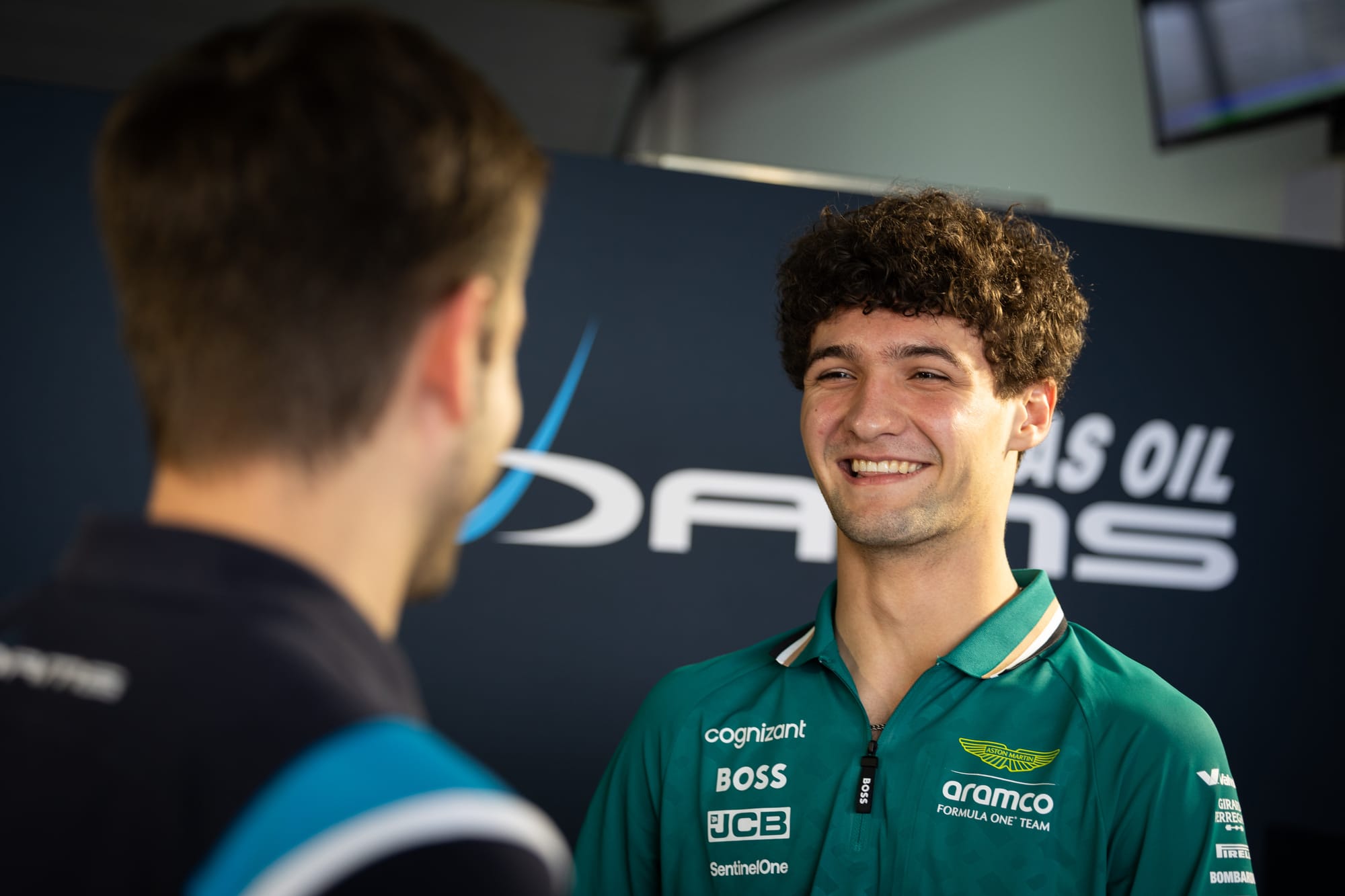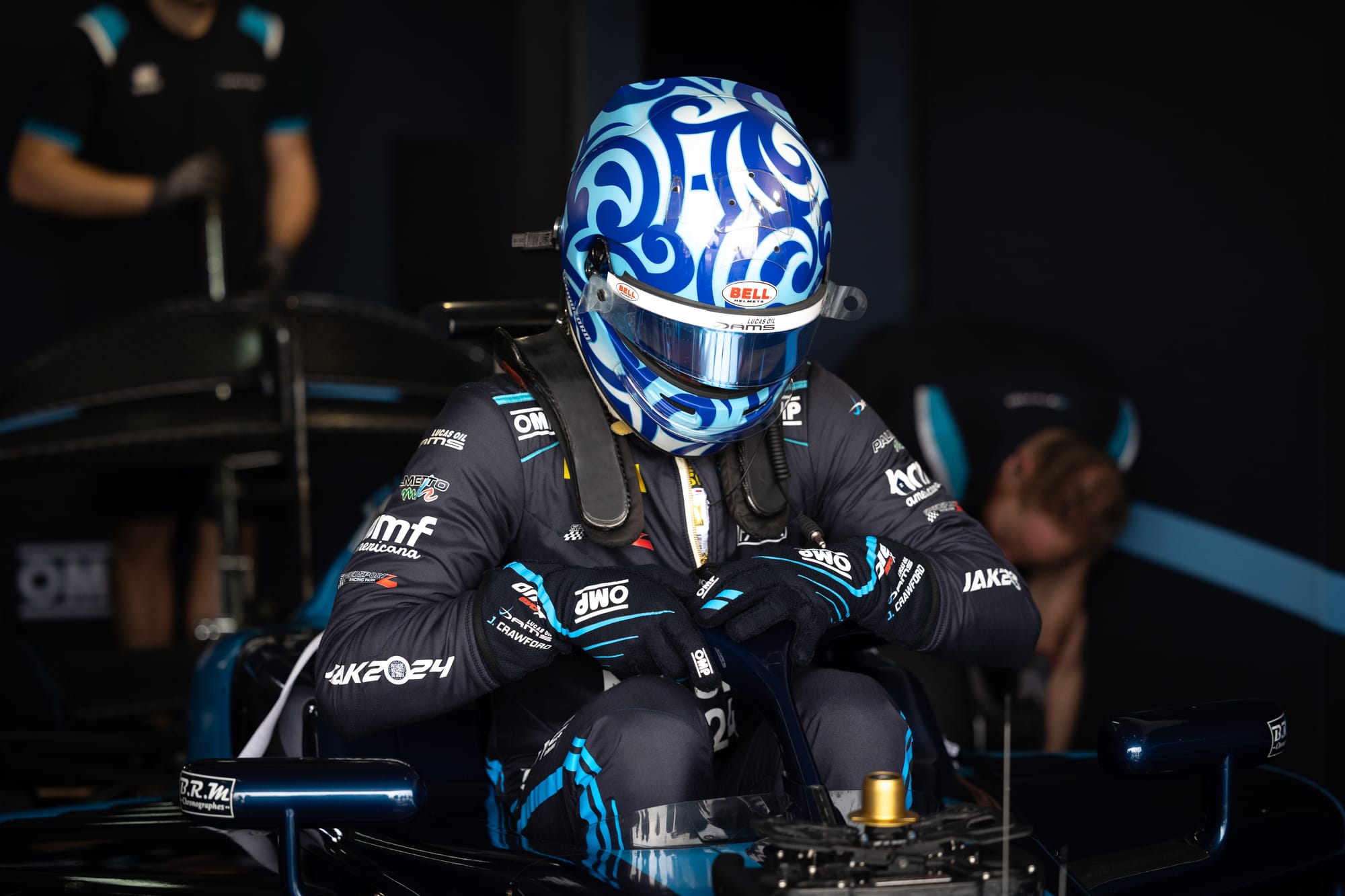An ocean away from home, a Houston Rockets-branded basketball hoop dangles from a closet door, the only splash of color in an otherwise all-white kitchen. It’s a Monday evening in Milton Keynes, England, roughly 50 miles northwest of London, and Jak Crawford, one of the most promising young American race-car drivers of his generation, settles into a seat in the apartment he’s called his own for the past couple of years and lays out his schedule for the week.
Today, Crawford finished a training evaluation at the gym; tomorrow, it’s a full day in the race simulator. Wednesday, he’ll have a session with his sports psychiatrist, then hop a quick flight to France to do more simulator work, then another psychiatry session on Friday morning. Saturday’s his day off, but if he’s not cleaning his place or doing his laundry, he often spends it in the race simulator he’s got at his apartment.
And then, the next week, he’ll do it all again.
“For sure it gets lonely,” he says. “But it’s so intense, and there’s so much going on, and I’m around so many people all day that you kind of forget about it. It’s actually quite nice just to come home alone and put on some TV or something.”
Crawford is still only 18 years old. The friends he made growing up in Houston are well into college now, but Crawford’s teenage experience diverged from theirs years ago. He decided long ago that this was the life he wanted. When he was 14, a man named Helmut Marko plucked him out of the crowd of aspiring drivers and told Crawford he had the potential to become that rarest of things: A Formula 1 driver. Crawford moved to Europe on his own, joined the Red Bull junior program overseen by Marko, and set his sights on the highest level of racing. And he’s been laboring on that path ever since.
And as he prepares for his second season on the Formula 2 circuit, Crawford finds himself at a crossroads: In the offseason, he cut ties with Marko and Red Bull. He joined a new racing team, switching to the French outfit DAMS, and racing media reported that he’ll soon join a new junior developmental program sponsored by Aston Martin (though when we spoke, the announcement wasn’t official yet).

Crawford remains one of the youngest drivers on the F2 circuit. And yet, as the beginning of the F2 season looms in Bahrain at the end of February, this feels more and more like a crucial stretch for him. There are only 20 seats for drivers in Formula 1; many of them stay occupied for decades, and the open seats are often determined through capricious factors like sponsorship potential. But if Crawford can make an impression on F2 this season – if he can at least put himself in the running for the F2 championship – he has one advantage: He’s an American in a sport that’s boomed in popularity in this country, thanks in large part to the Netflix series Formula 1: Drive to Survive.
There’s an opening here, and Crawford is determined to do everything he can to maximize his chances, even if it means continuing to live a life thousands of miles removed from his parents in Houston. There’s no real money in any of this until he reaches F1. For now, he has to rely largely on his parents to pay his rent and expenses. But they’re as invested in the success of their only child as he is.
“My dad and I share a passion,” Crawford says. “For me to get to Formula 1, I think it’d be a big weight off their shoulders.”
Crawford’s story begins long before Formula 1 leapt into the American zeitgeist and years before it leapt into his own consciousness. It begins with a young kid in Charlotte watching NASCAR races with his father, Tim, and Tim letting him tool a go-kart around a parking lot. The family moved to Houston and went to local tracks, where Jak, aged six, picked things up so quickly that he started winning races within a year, driving a tiny kart and wearing a massive crash helmet that engulfed his small head. When Jak was 10, he finished second at a karting race in Italy, and Jak and his father began to think seriously about how far he could go.
“Ever since I was young, I've just been racing," Crawford says. "It's not like it was a choice to do something else — it's always just been my life. So I feel like it was almost destined.”
Even then, the Crawfords imagined the target would be either NASCAR or the IndyCar circuit. They imagined if Crawford would make a name for himself in racing, it would be in America. But the Europeans saw Crawford’s karting skills, and began to evaluate his potential for the Formula 1 circuit. And when it happened, it happened fast: One day in 2020, Crawford was graduating from karting and moving toward the open-wheel IndyCar path, and the next, his dad got an email, and Crawford found himself trying out for the Red Bull team on a track in Austria. Red Bull offered him a contract on the spot. Crawford took it, moved to England, finished his high-school degree online, and put his career in the hands of Marko, an F1 driver whose career ended after a freak accident during a race blinded him in his left eye.

The pressure of performing for Marko was a challenge for Crawford. The expectations were sky-high; the competition was intense. A bad weekend of racing meant a difficult conversation with Marko. He didn’t always feel like he had complete control of his future.
“I have a crucial year in F2,” he says. “And at the end of the day, I felt like Red Bull wasn’t the best place for me to move my career forward.”
And so after cutting ties with Red Bull after four years, he felt a certain sense of relief. He still has a bright future and some new energy around him. And regular conversations with his sports psychiatrist helped him work through his feelings and focus on what he actually wanted.
“There's so much that can go through your mind, and especially when you're fighting for a championship, a lot of things can go through your mind and it's very easy to make mistakes when that happens,” he says. “It's very easy to overthink things… It’s going to be a long year, a busy year. But I’m excited for it.”
Last October, American driver Logan Sargeant became the first American in three decades to score a Formula 1 point during a race. And while Sargeant qualified again for the 2024 season, Crawford believes there’s room for an American not just to hang around on the circuit, but to compete at the highest level.

“First of all, you have to bring the results and show you have potential,” Crawford says. “But then there’s another aspect – what brands do you attract? What sponsorship do you attract? And being American obviously helps with that, as well. So there’s definitely a lot of factors other than driver performance.”
How it might work out for him, Crawford has no idea. It will take a tremendous amount of skill and a little bit of luck to make that leap from Formula 2 to Formula 1. If he doesn’t make it, he figures he’ll move back to America and make a run at either IndyCar or NASCAR. But for now, he wants to chase after what he believes are the best drivers he’ll find anywhere.
“Formula 1 is the fastest cars in the world on a road course, with very big brands and teams,” Crawford says. “So I think it’s the ultimate pinnacle of motorsport.”
Crawford pauses. Thinks about the glory and the money that would come with a spot in Formula 1. Thinks about the validation that would arrive after all these years of effort. And thinks, most of all, about his family.
“I think my parents would be really happy to see me finally reach my dream,” he says. “Maybe they can get themselves a nice boat.”